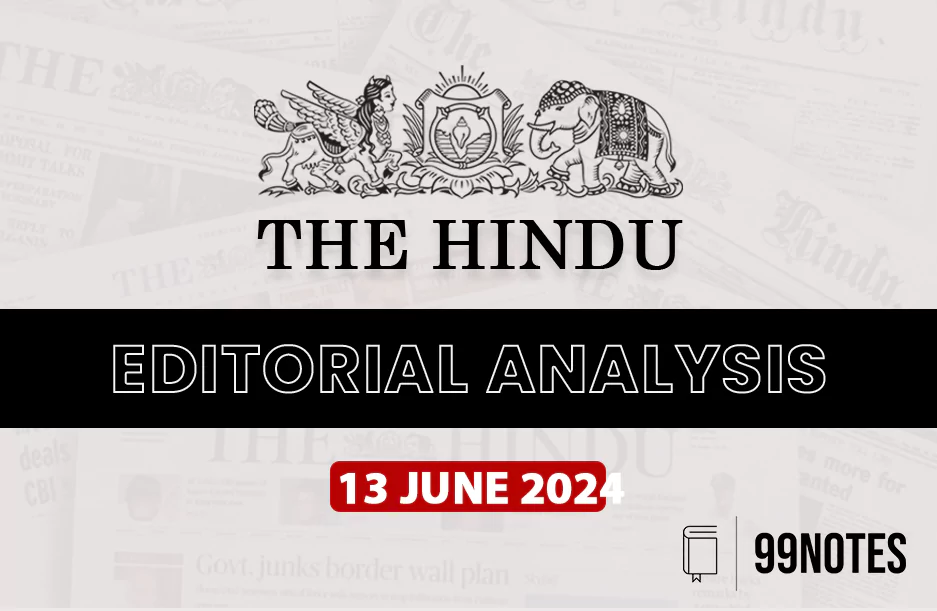14 June 2024 : The Hindu Editorial Analysis
1. Do coalition governments slow down the economic reforms agenda?
| Topic: GS2 – Governance |
| Context |
|
Introduction
- Until the 2014 Lok Sabha elections, India experienced coalition governments for 21 years.
- The Bharatiya Janata Party (BJP) won 282 seats in 2014, but ten years later, the BJP has 240 seats, leading to a coalition government.
- Fitch had noted that coalition politics and a weakened mandate could hinder ambitious reform legislation.
Policy Concessions in Coalition Governments
- The idea that single-party governments are the norm and coalition governments are aberrations is questioned.
- Comparative studies show that single-party governments do not always act as unitary entities.
- Both single-party and coalition governments involve competing ideas and interests, leading to policy compromises and bargains.
- In multi-party governments, these compromises are more transparent as they occur in the public domain.
- India’s experience with coalition governments has not been negative; they have provided checks and balances that have improved governance.
Economic Growth and Reforms
- Economic growth is often linked to reform, and decisiveness in reform is thought to require a single-party majority.
- However, economic liberalisation in India began under various governments, including coalition and minority governments.
- Earlier coalition governments, despite a social democratic agenda, had mixed results on social policy reforms.
- Negotiations and compromises in coalition governments can lead to more stable and long-term policies, even if reforms are less radical.
- Single-party majority governments may lack checks and balances, leading to potentially unfavourable policy decisions.
Performance of Past Coalition Governments on Economic Agenda
- There has been continuity in economic policies across different governments since 1991, with gradual and incremental changes.
- Public bargaining in coalition governments ensures that various viewpoints are considered and accommodated.
- Decision-making mechanisms in coalition governments, like committees and groups of ministers, have institutionalised the process of accommodating different voices.
- Coalition governments have often performed better in implementing reforms compared to single-party governments.
- Single-party governments may make hasty decisions without broader consensus, such as the controversial farm laws.
Role of Institutions in Coalition Governments
- Coalition governments tend to activate institutions that facilitate and promote Centre-State relations.
- Allies in coalition governments are often regional parties, leading to a more informed but sometimes turbulent policy-making process.
- Dialogues in coalition governments can become acrimonious, and there have been instances where reforms were stalled.
- However, there is no inherent disadvantage in coalition governments compared to single-party governments.
- Historical examples show that single-party governments also faced internal checks that hindered reform agendas.
State’s Share in Divisible Pool of Taxes
- The role of State governments is higher in national coalitions, and they may expect a larger share of taxes.
- Despite initial pledges to strengthen federalism, the Centre’s share of revenue has increased due to special cesses and the abolition of the Planning Commission.
- Niti Aayog, which replaced the Planning Commission, is seen as more technocratic and beholden to the Centre.
- Political centralization in decision-making has increased, leading to greater control over social welfare benefits by the Union government.
- The division of taxes between the Centre and States is complex, influenced by economic performance, regional disparities, and GST negotiations.
- The GST architecture is seen as unfavourable to the States, with revenue declines due to lower tax brackets for certain commodities.
Economic Vision of the National Democratic Alliance Constituents
- The present government needs allies for a majority, but key ministries remain with the largest party, raising questions about potential changes in governance style.
- Allies in the coalition have a liberal economic outlook, but the distribution of power and decision-making style could differ.
- Economic policies across parties are generally aligned on reforms, with differences mainly in the pace of decision-making.
- The involvement of more people in decision-making in coalition governments leads to more stable and enduring policies.
Conclusion
- The more inclusive decision-making process in coalition governments ensures policy stability and continuity.
- Coalition governments have checks and balances that single-party governments may lack, leading to more considered and balanced policy decisions.
- While coalition politics can complicate reform processes, they also facilitate broader consensus and long-term stability in policies.
- India’s experience with coalition governments shows that they can be effective in economic and social policy reforms, despite potential challenges.
| Practice Question: Analyse the impact of coalition governments on the implementation of economic reforms in India. How do coalition dynamics influence policy-making and stability compared to single-party governments? (250 Words /15 marks) |
(Source – The Hindu, International Edition – Page No. – 9)


